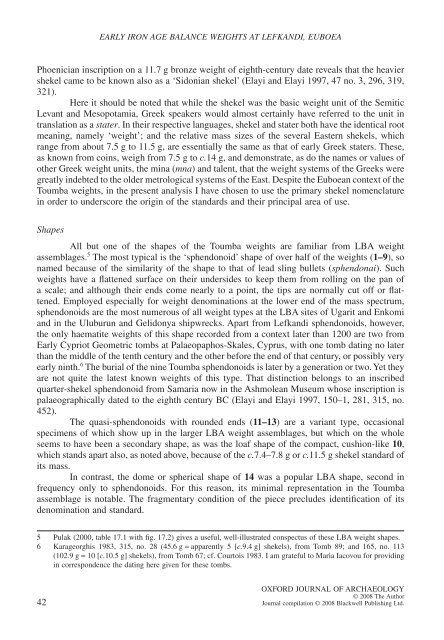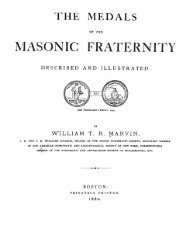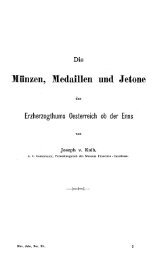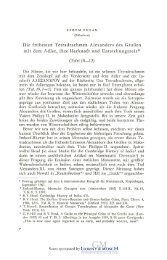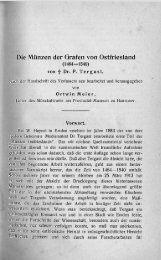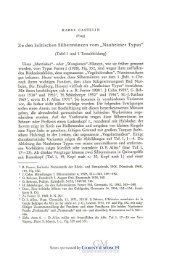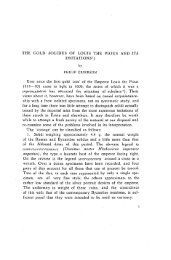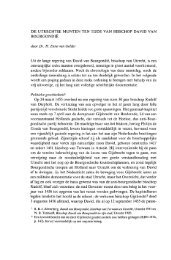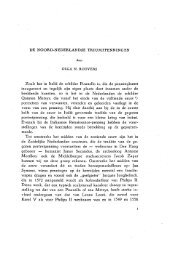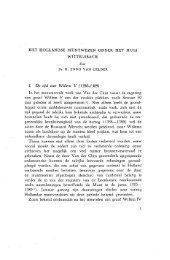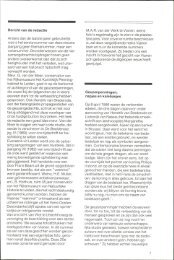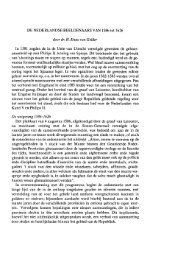Early Iron Age balance weights at Lefkandi, Euboea
Early Iron Age balance weights at Lefkandi, Euboea
Early Iron Age balance weights at Lefkandi, Euboea
You also want an ePaper? Increase the reach of your titles
YUMPU automatically turns print PDFs into web optimized ePapers that Google loves.
EARLY IRON AGE BALANCE WEIGHTS AT LEFKANDI, EUBOEA<br />
Phoenician inscription on a 11.7 g bronze weight of eighth-century d<strong>at</strong>e reveals th<strong>at</strong> the heavier<br />
shekel came to be known also as a ‘Sidonian shekel’ (Elayi and Elayi 1997, 47 no. 3, 296, 319,<br />
321).<br />
Here it should be noted th<strong>at</strong> while the shekel was the basic weight unit of the Semitic<br />
Levant and Mesopotamia, Greek speakers would almost certainly have referred to the unit in<br />
transl<strong>at</strong>ion as a st<strong>at</strong>er. In their respective languages, shekel and st<strong>at</strong>er both have the identical root<br />
meaning, namely ‘weight’; and the rel<strong>at</strong>ive mass sizes of the several Eastern shekels, which<br />
range from about 7.5 g to 11.5 g, are essentially the same as th<strong>at</strong> of early Greek st<strong>at</strong>ers. These,<br />
as known from coins, weigh from 7.5 g to c.14 g, and demonstr<strong>at</strong>e, as do the names or values of<br />
other Greek weight units, the mina (mna) and talent, th<strong>at</strong> the weight systems of the Greeks were<br />
gre<strong>at</strong>ly indebted to the older metrological systems of the East. Despite the <strong>Euboea</strong>n context of the<br />
Toumba <strong>weights</strong>, in the present analysis I have chosen to use the primary shekel nomencl<strong>at</strong>ure<br />
in order to underscore the origin of the standards and their principal area of use.<br />
Shapes<br />
All but one of the shapes of the Toumba <strong>weights</strong> are familiar from LBA weight<br />
assemblages. 5 The most typical is the ‘sphendonoid’ shape of over half of the <strong>weights</strong> (1–9), so<br />
named because of the similarity of the shape to th<strong>at</strong> of lead sling bullets (sphendonai). Such<br />
<strong>weights</strong> have a fl<strong>at</strong>tened surface on their undersides to keep them from rolling on the pan of<br />
a scale; and although their ends come nearly to a point, the tips are normally cut off or fl<strong>at</strong>tened.<br />
Employed especially for weight denomin<strong>at</strong>ions <strong>at</strong> the lower end of the mass spectrum,<br />
sphendonoids are the most numerous of all weight types <strong>at</strong> the LBA sites of Ugarit and Enkomi<br />
and in the Uluburun and Gelidonya shipwrecks. Apart from <strong>Lefkandi</strong> sphendonoids, however,<br />
the only haem<strong>at</strong>ite <strong>weights</strong> of this shape recorded from a context l<strong>at</strong>er than 1200 are two from<br />
<strong>Early</strong> Cypriot Geometric tombs <strong>at</strong> Palaeopaphos-Skales, Cyprus, with one tomb d<strong>at</strong>ing no l<strong>at</strong>er<br />
than the middle of the tenth century and the other before the end of th<strong>at</strong> century, or possibly very<br />
early ninth. 6 The burial of the nine Toumba sphendonoids is l<strong>at</strong>er by a gener<strong>at</strong>ion or two. Yet they<br />
are not quite the l<strong>at</strong>est known <strong>weights</strong> of this type. Th<strong>at</strong> distinction belongs to an inscribed<br />
quarter-shekel sphendonoid from Samaria now in the Ashmolean Museum whose inscription is<br />
palaeographically d<strong>at</strong>ed to the eighth century BC (Elayi and Elayi 1997, 150–1, 281, 315, no.<br />
452).<br />
The quasi-sphendonoids with rounded ends (11–13) are a variant type, occasional<br />
specimens of which show up in the larger LBA weight assemblages, but which on the whole<br />
seems to have been a secondary shape, as was the loaf shape of the compact, cushion-like 10,<br />
which stands apart also, as noted above, because of the c.7.4–7.8 g or c.11.5 g shekel standard of<br />
its mass.<br />
In contrast, the dome or spherical shape of 14 was a popular LBA shape, second in<br />
frequency only to sphendonoids. For this reason, its minimal represent<strong>at</strong>ion in the Toumba<br />
assemblage is notable. The fragmentary condition of the piece precludes identific<strong>at</strong>ion of its<br />
denomin<strong>at</strong>ion and standard.<br />
5 Pulak (2000, table 17.1 with fig. 17.2) gives a useful, well-illustr<strong>at</strong>ed conspectus of these LBA weight shapes.<br />
6 Karageorghis 1983, 315, no. 28 (45.6 g = apparently 5 [c.9.4 g] shekels), from Tomb 89; and 165, no. 113<br />
(102.9 g = 10 [c.10.5 g] shekels), from Tomb 67; cf. Courtois 1983. I am gr<strong>at</strong>eful to Maria Iacovou for providing<br />
in correspondence the d<strong>at</strong>ing here given for these tombs.<br />
42<br />
OXFORD JOURNAL OF ARCHAEOLOGY<br />
© 2008 The Author<br />
Journal compil<strong>at</strong>ion © 2008 Blackwell Publishing Ltd.


